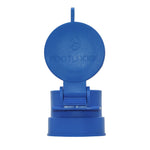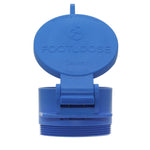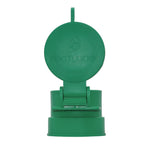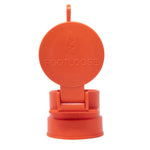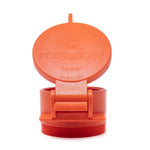No tiene artículos en su carrito de compras.
Composite (FRP/SMC) manhole covers are no longer niche. Utilities, campuses, refineries, and municipalities are adopting them to solve everyday problems that metal lids struggle with: handling injuries, corrosion, theft, and stray-current risks. Today’s best composites meet recognized load classes for roads and industrial areas, while bringing ergonomic and safety advantages that cast-iron can’t match.
What “composite” means (and how strong they are)
Most composite covers are built from fiber-reinforced polymer (FRP) or sheet-molding compound (SMC) engineered for structural stiffness and impact resistance. Leading products are tested to EN 124:2015 load classes—from A15 (pedestrian) through D400 (roadways) and, for some models, even E600/F900 for exceptional wheel loads. That means you can choose a composite cover for sidewalks, streets, or heavy-duty industrial zones and specify by the same class language you’d use for any cover.
U.S. buyers: if your spec uses AASHTO M306 proof loads for “traffic-rated” castings, many composite assemblies are designed and marketed to meet comparable traffic service in roadway applications—check the manufacturer’s AASHTO/M306 documentation.
1) Lighter weight = better ergonomics and fewer injuries
Composite lids can be dramatically lighter than ductile iron—often up to ~70% less—which pays off during routine inspections and emergency responses. Lighter components reduce the need for two-person lifts and lessen strain when positioning lids. The ergonomics case is simple: the NIOSH Lifting Equation uses a 51-lb “load constant” under ideal conditions; many metal lids exceed that by a wide margin, so mechanical aids or lighter materials make work safer and faster.
2) Corrosion resistance in aggressive environments
Wastewater gases (e.g., hydrogen sulfide) and coastal salt exposure are hard on metals. Composite covers don’t rust and don’t need repainting, which helps lids keep their seal and appearance with far less upkeep—a lifecycle win for humid, coastal, or H₂S-rich locations.
3) Non-conductive safety near power, rail, and fueling
Unlike metal, composites are electrically non-conductive and thermally insulating. That reduces stray-current and shock hazards around electrified rail, substations, or fueling facilities and helps minimize “hot surface” risks in summer sun. Manufacturers highlight these properties specifically for assets in utilities and forecourts.
4) Built-in anti-theft advantage
Metal lids have scrap value, which makes them targets during high metal-price cycles. Composites contain no resale metal, and cities that switched report fewer theft incidents and safer streets as a result. If cover theft is a recurring line item (or a public-safety concern), composites can eliminate the incentive.
5) Slip-resistant surfaces and cleaner site safety
Many composite covers are molded with anti-slip textures that maintain friction when wet—useful in pedestrian areas, pump yards, and fueling forecourts. Ask for surface-friction data and test standards (e.g., pendulum tests) with your submittals.
Where composites shine (and when to stick with iron)
Great fits for composites
-
Pedestrian zones & campuses: lighter, non-conductive, slip-resistant tops make inspections and crowd safety easier.
-
Coastal & H₂S environments: corrosion-proof materials maintain seals and appearance without repainting.
-
Fueling sites & utilities: non-sparking/non-conductive construction is a plus around electrical equipment and forecourts.
-
Theft-prone corridors: no scrap value means fewer replacements and fewer emergency barricades.
When ductile iron may still be preferred
-
Agency standards: some owners mandate ductile iron on specific routes.
-
Special sizes/legacy frames: if a unique frame pattern only exists in metal, stay with the approved casting (or plan a frame swap).
Selecting composite covers: a quick spec checklist
-
Load class: Specify EN 124 class to match location (A15/B125 footways; C250 curb; D400 streets; E600/F900 for heavy industry/airside), or require the manufacturer’s documentation for AASHTO M306 traffic service where applicable.
-
Surface & sealing: Anti-slip top; gasketed lids for odor/inflow control; bolting where ponding or security is a concern.
-
Ergonomics: Confirm one-person removal with a rated lifter or magnet; include handling instructions in the O&M manual. The lighter weight reduces reliance on strenuous manual lifts (remember the 51-lb NIOSH benchmark).
-
Compatibility & retrofits: If reusing frames, verify fit or plan to replace frames with composite-compatible assemblies in traffic areas.
-
Documentation: Request test reports for EN 124 class, slip resistance, and any M306 proof-load claims.
Maintenance advantages you’ll actually notice
-
Faster inspections: One person with a lifter can open/close more structures per shift, with less fatigue. The time saved adds up on large networks.
-
Fewer corrosion repairs: No rust cleanup, repainting, or stuck hinges.
-
Lower replacement risk: No scrap value means fewer theft-driven outages and emergency barricades.
Real-world adoption snapshots
-
Municipal anti-theft programs: Cities plagued by stolen lids have replaced cast iron with composites to remove the scrap incentive and improve public safety.
-
Heavy-duty roadway use: Composite assemblies are offered and installed with D400–F900 ratings in demanding applications; check the manufacturer’s installation guides and class certificates.
Model spec language (adapt to your owner standards)
Frames & Covers – Composite
-
Provide composite (FRP/SMC) frame and cover assembly tested to EN 124:2015 Class D400 (streets) unless noted otherwise. Submittals shall include test certificates and surface-friction data for the supplied texture.
-
Where the owner requires “traffic-rated” performance under U.S. practice, provide manufacturer documentation showing compliance with AASHTO M306 traffic service for the supplied assembly.
-
Cover shall be non-conductive, corrosion-resistant, and anti-slip; provide gasket and bolting where indicated on plans (in low points or flood-prone areas).
-
Provide handling instructions and compatible lifting points for safe one-person removal using mechanical aids; avoid manual prying. Reference ergonomics guidance based on the NIOSH Lifting Equation.



